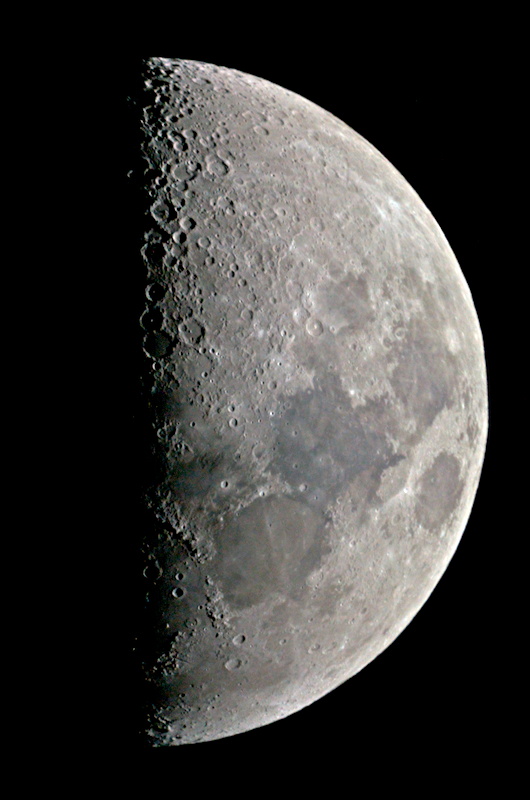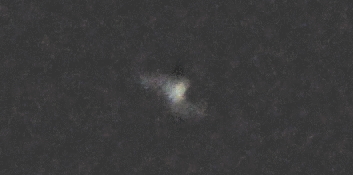
Imaging: Moon, Jupiter, ISS, Mars;
First POD Roller Desk Use
Posted: 1 March 2012
Opened the observatory Wednesday, 29 February 2012, at 1807 MST, 68°F. The sky was mostly clear but very hazy, and there was a slight breeze blowing. This would be my first night of observing since making my "POD Roller Desk" and I looked forward to seeing how well it worked. At 1812 MST, viewed Venus, Mercury, and then the moon, 77X. Next, I updated the current ISS TLE into the AutoStar II for this night's short ISS pass.
I began some lunar observing at 1838 MST at 77X and 206X. Montes Apenninus showed a very nice 3D height effect due to the shadows. I selected Crater Walter as a high magnification imaging target; it showed a nice central peak shadow. I then mounted the D7000 DSLR at prime focus of the 8" LX200-ACF and took this image of the moon, 1/250sec, ISO 500:

Here is Crater Walter, prime focus + 3X TeleXtender, "Hat Trick", ISO 500, cropped from a full-frame image:

I then did some video recording tests of Jupiter, prime focus + 3X TeleXtender. Seeing was not very good at this point but I was more interested in doing exposure setting tests. This is a stack of 1104 video frames using Keith's Image Stacker, 1/200sec, ISO 5000, cropped and upscaled 200%:

I then prepared for the ISS pass. Telescope focus was locked, finderscope alignment checked (and tweaked), northeast neighbor turned on nuisance floodlight (an energy resource waste as well as adding to the global light pollution problem). This pass would not be ideal for a fork and wedge mounted telescope; the finderscope would pass through the fork arms, making tracking impossible at some point. During the actual ISS pass, AutoStar tracking was horrible this night. I never really managed to keep the ISS near the finderscope crosshair. There were 2 frames in the 3 minute, 12 second, video that had a blur of the ISS. This is one of those frames, cropped, prime focus + 3X TeleXtender:

Yes, those are solar panels on the left and right.
At 1945 MST, I returned to Jupiter observing, 77X, and then the moon, 77X and 364X. Seeing was pretty good at the moon, even with the haze. Shadows were fascinating along the terminator with some excellent sights. I tried using 619X but seeing was not quite good enough for that much magnification, so switched back 364X. The crater Alphonsus was very impressive. The central peak was very brightly illuminated and there was a long narrow shadow running to the crater wall. I decided to image it with the D7000 DSLR at prime focus + 3X TeleXtender. This is the cropped result, "hat trick", ISO 500:

Next, I had to swap the rechargeable batteries in the Wireless AutoStar II. The batteries are only lasting about 2 weeks being recharges, probably due to the low night time temperatures.
I ended lunar observing at 2120 MST and went to Mars. I used 77X and 206X. Seeing was not good. I added the moon filter, which improved the view a little bit. The North Polar Cap was just barely visible but I could see no dark surface markings. At 2125 MST, the northeast neighbor finally turned off the nuisance light, after leaving it on for about 2 hours. At 2150, MST, the north neighbor decided to start his energy waste and light pollution; fortunately, he left it on for only 7 minutes. At 2155 MST, seeing had slightly improved and I could just make out a dark area on the surface of Mars at 206X. The sky was still very hazy; there continued to be a large glow surrounding the moon. I began some video recording exposure tests of Mars at 2213 MST, prime focus + 3X TeleXtender. First, I did a focus test on the star Regulus using the Bahtinov Mask. This is a stack of 1125 frames, 1/200sec, ISO 3200, cropped and upscaled 200%:

This image closely matches what I saw in the eyepiece. I think I have now determined a good exposure setting for Mars as it gets near its opposition and closest approach to the Earth.
I ended imaging at 2219 MST and did some Mars observing, 206X, 133X, and 77X. Seeing continued to be not very good. I started closing up the observatory.
The observatory was closed at 2239 MST, 45°F.
So, how well did my new POD Roller Desk work out?
Very well. I added two large paper clips to hold my log book open during the breezes. The desk was freely pushed along on the POD wall by the dome as it was rotated. The desk was very stable on the POD wall. Having my log book easily at hand without needing to balance it on my lap was a real convenience.

Go to the previous report.
Return to the Cassiopeia Observatory Welcome Page.